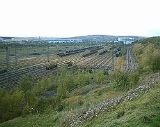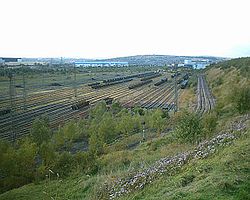
Tinsley Marshalling Yard
Encyclopedia

Classification yard
A classification yard or marshalling yard is a railroad yard found at some freight train stations, used to separate railroad cars on to one of several tracks. First the cars are taken to a track, sometimes called a lead or a drill...
located near Tinsley in Sheffield
Sheffield
Sheffield is a city and metropolitan borough of South Yorkshire, England. Its name derives from the River Sheaf, which runs through the city. Historically a part of the West Riding of Yorkshire, and with some of its southern suburbs annexed from Derbyshire, the city has grown from its largely...
. It was opened in 1965 as a part of a major plan to rationalise all aspects of the rail services in the Sheffield area, and closed in stages from 1985 with the run-down of rail freight in Britain. It was also the site of Tinsley Traction Maintenance Depot
Tinsley Motive Power Depot
Tinsley Motive Power Depot, latterly Tinsley Traction Maintenance Depot was built as part of the Sheffield district rail rationalisation plan of the 1960s opening during 1965 and situated adjacent to, but at a higher level than the new Tinsley Marshalling Yard alongside the Sheffield District...
(TMD
Traction maintenance depot
In the United Kingdom, a traction maintenance depot, or TMD, is a railway depot where locomotives are serviced and maintained. A traction and rolling stock maintenance depot, or T&RSMD, is a maintenance depot where locomotives, multiple units and rolling stock are serviced and maintained. Each rail...
), which was closed in 1998. At its peak 200 locomotives were allocated to this depot.
History of the yard
In 1961, a tenth of the rail-borne freight in Britain originated in the Sheffield district. However, as with many areas, the provision of freight facilities had grown through cramped, piecemeal developments associated with the various operating companies that built Britain's rail system. With the region being one of the main heavy industry heartlands of Britain, government money was made available to remedy this situation. Central economic planning and economic self-sufficiency were government policy; the situation was seen as a major limit on Britain's economic growth.The plan called for the replacement of the majority of the marshalling yards in the Sheffield area with one large yard. A location on the Sheffield District
Sheffield District Railway
The Sheffield District Railway was a railway line in South Yorkshire, England with its main line running between Brightside Junction, on the Midland Railway's Sheffield to Rotherham line, and Treeton Junction, on the same company's Rotherham to Chesterfield line...
line was chosen and work started in 1963 with the digging out of Brinsworth tunnel. The location allowed easy access to the brand new central Sheffield Freight Terminal at Grimesthorpe, and the new Freightliner terminal on the site of the Masborough Sorting Sidings in Rotherham, one of the many yards that Tinsley replaced.
The locomotive depot opened in 1964, with diesel locomotives moving in from a temporary home in the old Grimesthorpe steam locomotive depot. The Sheffield electric locomotive depot was moved from Darnall to Tinsley and the Darnall Steam/Electric locomotive depot closed to become a wagon-repair depot. Other steam locomotive depots at Millhouses and Canklow were closed and the last steam locomotives based in the Sheffield area were scrapped, along with many redundant sidings dotted about the area.
In 2006 the yard reached the national news when two youths took to the site and joyrode a 49-tonne shunting engine up and down the tracks. Source: BBC News.
The Tinsley complex was opened by Dr Beeching
Richard Beeching
Richard Beeching, Baron Beeching , commonly known as Doctor Beeching, was chairman of British Railways and a physicist and engineer...
, former Chairman of the British Railways Board
British Railways Board
The British Railways Board was a nationalised industry in the United Kingdom that existed from 1962 to 2001. From its foundation until 1997, it was responsible for most railway services in Great Britain, trading under the brand names British Railways and, from 1965, British Rail...
, on 29 October 1965.
The yard
From its outset, Tinsley was to be a "Network Yard": a major railfreight node where wagon-load freight trains would arrive, be split and resorted into new trains for onward departure to other Network yards, directly to the many rail-connected businesses in the area in "trip" freights, or to the Freight Terminal for unloading and forwarding by road. To assist with this, it featured gravity-assisted shuntShunt (railway operations)
Shunting, in railway operations, involves the process of sorting items of rolling stock into complete train sets or consists. The United States terminology is "switching"....
ing and a new computerised system of wagon control, along the lines of large US rail freight yards.
At the time of opening, the yard was handling 3,000 wagons a day. Incoming trains were split in the 11 reception sidings, propelled over the hump in the yard, from where the individual wagons rolled down a slope and were automatically sorted into new trains on the Yard's 50 main sorting sidings
Rail siding
A siding, in rail terminology, is a low-speed track section distinct from a running line or through route such as a main line or branch line or spur. It may connect to through track or to other sidings at either end...
. The yard even had its own dedicated class of shunting locomotive (British Rail Class 13
British Rail Class 13
The British Rail Class 13 were created in 1965 because of a necessity to provide more powerful shunters for the Tinsley Marshalling Yard. This was achieved by permanently coupling together two Class 08 shunters as a 'master and slave' units, the latter with its cab removed...
) for this purpose as BR's standard class of shunting locomotive was not powerful enough for use in the yard. Each of the main sorting sidings was fitted with computer-controlled retarders to either slow the rolling wagons down before they hit other wagons already on the siding, or give wagons rolling too slowly a boost to move them along to the correct position in a particular siding. This wagon-control system, manufactured by Dowty
Dowty
Dowty may refer to:*Alan Dowty, an international relations scholar*David Dowty, an American linguist.*Dowty Group, a British aircraft equipment manufacturing business.**Ultra Electronics was created by the demerger of seven Dowty companies in 1993....
, was very complex, needed almost constant maintenance, and crucially could not handle longer wheelbase wagons, which were already becoming more prevalent and required individual shunting. There was an express freight and departure yard of 10 sidings, and a 25 road secondary yard for local freight trains (with its own hump).
The Manchester-Sheffield-Wath electrification
Manchester-Sheffield-Wath electric railway
The Manchester-Sheffield-Wath electric railway was an early electrification scheme on British railways. The route featured long ascents on both sides of the Pennines with the long Woodhead Tunnel at its central summit close to the Woodhead pass...
was extended into the yard in 1965 to allow electrically-hauled trains to the Manchester area to be handled. Seventeen miles of track from Woodburn Junction and Darnall Junction via Broughton Lane to Catcliffe were electrified at 1500V dc. The insulators were capable of being used at 6.25kV ac if ever required, with the option of 25kV ac with minimal conversion costs. Unlike similar electrified marshalling yards, to save on costs the main body of the sorting sidings was not electrified: a half of the arrival sidings was electrified for incoming electric trains; departing electric trains either had to use the southern third of the main sorting sidings (the western part of which were wired for electric trains) or had to be drawn out of the main sorting sidings by diesel locomotives into electrified departure roads where the electric locomotives were attached.
Decline
From an early stage the yard was not used at capacity: by the late 1960s road competition was biting hard into the railways' goods traffic, and in particular the wagon-load freight that required hump-yards like Tinsley was already declining. The economic malaise and industrial decline of the 1970s exacerbated this. By the 1980s BR was closing its remaining wagon-load freight facilities as being uneconomic.In 1981 the electrification was removed with the closure of the Manchester-Sheffield-Wath system.
On 17 December 1984 the arrival sidings and hump were closed, the wagon-control system removed and the remaining Class 13s scrapped. In 1985 the by now under-utilised Freight Terminal was severely damaged by a major fire and relegated to being a steel-loading facility. The yard connections were relaid to allow easier handling of block-load trains which now dominated rail freight in Britain.
By 1995 the decline in British heavy industry meant that this type of traffic had also declined massively. This resulted in the closure of the locomotive depot on 27 March 1998. The eastern connections (both North and South facing chords) to the Midland 'Old Road' had been lifted in 1993, and the western connection to the Midland Main Line
Midland Main Line
The Midland Main Line is a major railway route in the United Kingdom, part of the British railway system.The present-day line links London St...
(and goods depot at Grimesthorpe) at Brightside junction was lifted in 1999. Both chords to the ex MSLR/GCR line from Woodburn to Rotherham (via Broughton Lane junc and Tinsley South junc) remain open. The rest of the yard progressively fell into disuse over the next ten years.
A few years later only the main sorting sidings remained: a part of these were to be used to stable steel trains destined for the Sheffield area, the rest of the remaining sidings were used to store surplus-to-requirements rolling stock in a poor state of repair. However in 2007 the remaining sidings were lifted and a new, much smaller yard laid, the remaining area is taken the under-construction Sheffield International Rail Freight Terminal, a brand new rail-linked distribution and goods transshipment centre.
Regeneration
In the mid 2000s, the complex was renovated and reopened as the Sheffield International Rail Freight TerminalExternal links
- A computer-generated image of the new Sheffield International Rail Freight Depot currently under construction on the site of Tinsley yard.

